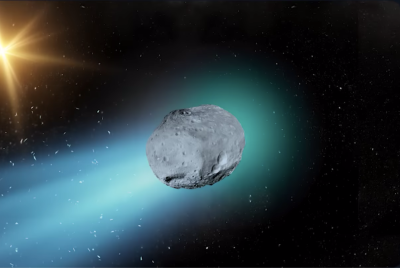NASA's Latest 3I/ATLAS Images Show a Strange Feature Of the Comet
Astronomer says there is an unusual feature about 3I/ATLAS in new images released by NASA

NASA has released the highest-resolution images yet of the interstellar comet 3I/ATLAS, captured by the Mars Reconnaissance Orbiter during its close approach to the Red Planet in October. The data release has reignited scientific debate, with Harvard physicist Avi Loeb citing anomalous plume trajectories as potential evidence of extraterrestrial technology, a claim the agency explicitly rejects.
Anomalous Plume Trajectories
The long-delayed images of 3I/ATLAS were finally released on 19 November, marking the closest look at the comet yet. One of the images was taken by the HiRISE camera attached to NASA's Mars Reconnaissance Orbiter and shows 3I/ATLAS passing by Mars in early October. Loeb, who has long theorised that 3I/ATLAS may be an alien spacecraft, identified irregularities in the comet's emissions.
According to Loeb, the jets emanating from 3I/ATLAS appear to be pointing in a different direction than expected. Specifically, they align with the direction of motion rather than the direction of the Sun, which was previously identified through data from the Hubble Space Telescope.
'It is easy to explain a plume of gas and dust extended towards the Sun as a result of the illumination of pockets of ice by sunlight or away from the Sun as a result of the radiation pressure or the solar wind,' Loeb wrote in a post on Medium. 'It is also possible to explain a trailing stream that the object leaves behind as the drag on the solar wind slows it down relative to the object.'
'But it is much more difficult to account for a plume extended perpendicular to the direction of the Sun and ahead of the object,' Loeb added. 'Could this be a technological signature of illuminating or clearing the path from any hazardous micrometeorites that may cause damage to a technological object?'
We've just released the latest images of the interstellar comet 3I/ATLAS, as observed by eight different spacecraft, satellites, and telescopes.
— NASA (@NASA) November 19, 2025
Here's what we've learned about the comet — and how we're studying it across the solar system: https://t.co/ZIt1Qq6DSp pic.twitter.com/ITD6BqVlGn
NASA Pushes Back on 'Alien' Claims
NASA Associate Administrator Amit Kshatriya has refuted Loeb's claims. In a livestream where the agency released some of its observations, Kshatriya addressed the speculation about 3I/ATLAS.
'This object is a comet,' said Kshatriya. 'It looks and behaves like a comet, and all evidence points towards it being a comet. But this one came from outside the Solar System, which makes it fascinating, exciting, and scientifically very important.'
NASA is currently on a campaign to view 3I/ATLAS through its multiple instruments, observing the comet through 12 lenses. Aside from the Mars Reconnaissance Orbiter, the Mars Atmosphere and Volatile Evolution (MAVEN) captured ultraviolet images for astronomers to determine the composition of the comet, while sun-monitoring instruments like the Solar Terrestrial Relations Observatory (STEREO) and the asteroid-observing Psyche and Lucy spacecraft captured their own observations of the comet.
Interstellar Origins
3I/ATLAS is known to have originated from outside the Solar System. While the specific origins remain undetermined, researchers believe that the comet is billions of years old. It may even be older than the Sun.
Tom Statler of NASA's Planetary Science Division said that because the comet is moving along three times faster than the average speed, it may have been in interstellar space for quite some time.
'We can't say this for sure, but the likelihood is it came from a solar system older than our own Solar System,' said Statler during the same livestream. 'Which gives me goosebumps to think about frankly, because that means that 3I/ATLAS is not just a window into another solar system; it's a window into the deep past, and so deep in the past that it predates even the formulation of our Earth and our Sun.'
© Copyright IBTimes 2025. All rights reserved.




















